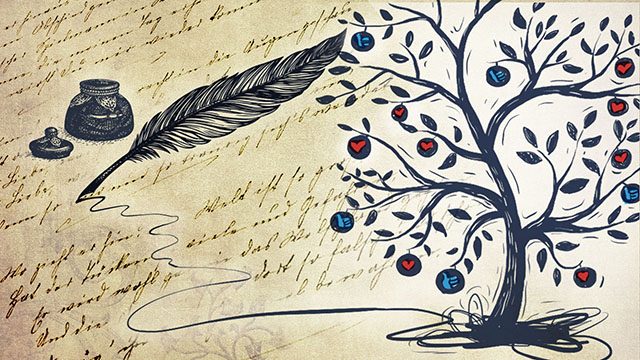SUMMARY
This is AI generated summarization, which may have errors. For context, always refer to the full article.

For a day, I became a student again. University of Santo Tomas assistant professor and Rappler columnist Joselito delos Reyes announced on Facebook that he could accommodate sit-ins for his class discussion on poetry that day.
He mentioned Lang Leav, and so I got even more interested because of a recent controversy sparked by how a Filpino poet wrote about her interview with the New Zealand-based best-selling author.
“It is rare for literature to be involved in an issue, or to be talked about,” Prof Jowie said in Filipino, as he opened his class.
Mookie Katigbak Lacuesta had written an article for ANCx about her interview with Leav, who was in Manila to promote her latest book, Love Looks Pretty On You. Mookie said Leav “qualified as an ally and not a figure of literature,” implying that Leav’s work may not be literary but it’s women-empowering. (READ: Q & A: Lang Leav on love, critics, and how she gets over writer’s block)
Many netizens found Lacuesta’s tone condescending, as if Leav’s works were a disdain to the world of Shakespeare, Oliver, Forché, Rich, Berryman or Plath. Leav herself tweeted to imply it was unbecoming of a journalist to have written about the interview that way. Writer Michael Faudet joined the long thread of tweets replying to ANCx in defense of his partner, Leav. Mookie’s husband, fictionist Sarge Lacuesta, also slammed the instapoet for her “substance over style” argument.
So is instapoetry not poetry? What constitutes a poem? Who says what is poetry and what isn’t? Based on what standards?
There’s formalism – and then there’s social media
The word “instapoetry” is not in the dictionary yet, but we mainly use it to refer to poems posted on Instagram or any social media platform, any poem written and posted in an instant. It is commonly written in short and free verse format. Its topics include but are not limited to romance, sex, self-help, and friendship.
Some believe that instapoetry became popular because of Rupi Kaur, a Canadian poet. Others give credit to Lang Leav. Many online readers patronize the writings of these two authors because of their emotionally striking and relatable lines. From Tumblr to Instagram posts, their works have become available offline as they were able to sell millions of copies of their books: Milk and Honey (2014) for Kaur and Love and Misadventure (2014) for Leav.
Aside from Leav, Faudette, and Kaur, Tyler Knott Gregson and Robert M. Drake have also made names as instapoets.
Easy access to social media platforms – such as Tumblr, Facebook, Twitter, and Instagram – has made recognition as instapoets possible for anyone and everyone who express themselves in stanzas sketched with abstract objects.
For Prof Jowie, instapoems are just aphorisms and clichés: “Hindi porket may verse, tula na. Hindi porket nagra-rhyme, tula na.” (It doesn’t become a poem just because it’s written in verse form. It doesn’t become a poem just because the lines rhyme.)
He’s not alone in that view. Critics from the academe look at these verses through the lens of literary criticism.
Here is where formalism enters. Formalism is the foremost approach to examining a poem or a narrative in literary criticism. It standardizes how the language is aesthetically used in the structure, rhyme, and symbols in the piece.
In the eyes of Ivor Armstrong Richards, TS Eliot, and Roman Jacobsen, good poetry involves the intricate use of language enveloped with critical thinking.
Prof Jowie also said during his class discussion, “A poem should imply…. It should make me ponder.”
Instapoetry won’t make anyone ponder; it does not even use language in a subtle way for its readers to think critically.
One can also critique a poem using reader response. The meaning of the poem depends on reader’s interpretation of the symbolism in the poem.
But instapoems are straightforward, they do not give any symbols to interpret.
Writing to express
However, we cannot deny the influence of instapoetry in creating a community of new writers and readers. They express themselves in the most convenient way that they can and have. Perhaps, they write to express and not to impress.
Professor Delos Reyes ended the class with a piece of advice: “P’wedeng hikayating magsuri ang mag-aaral sa kabila ng laban komportableng ease-of-use ng teknolohiya at social media platform.”
(We should persuade the students to examine [literature] amid the ease-of-use technology and social media platform.)
There is no harm in attempting to bring back the culture of reading especially in the age of scrolling.
Then, of course, what follows is another debate: while, instapoets get people to read and buy books, should this now be our standard for good literary work? I’d make my way to another talk to sit in and be enlightened. – Rappler.com
Add a comment
How does this make you feel?
There are no comments yet. Add your comment to start the conversation.